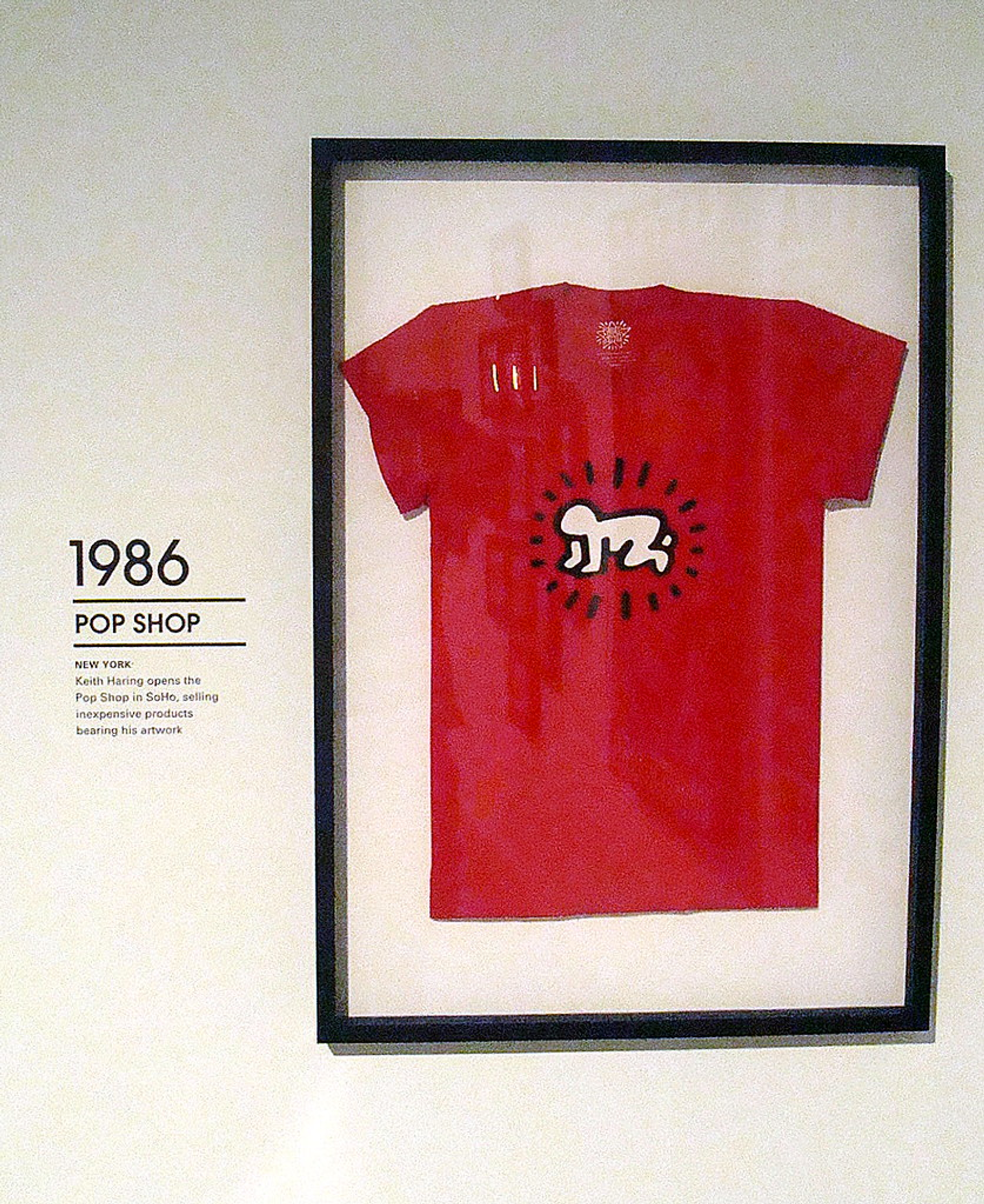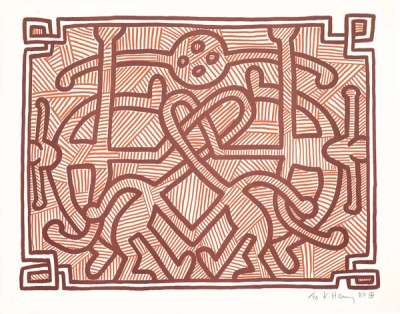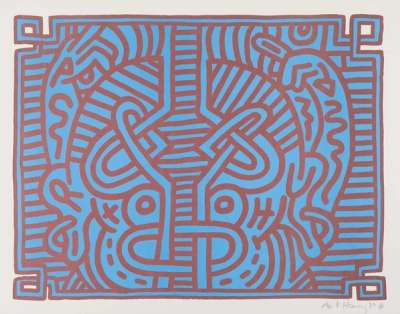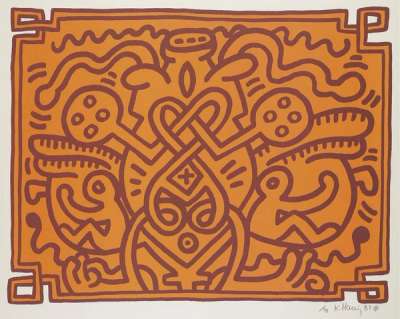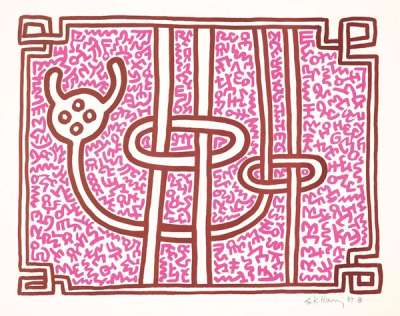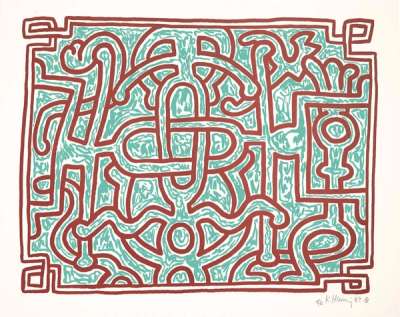Keith Haring's Chocolate Buddha

 Chocolate Buddha 2 © Keith Haring 1989
Chocolate Buddha 2 © Keith Haring 1989
Keith Haring
250 works
Haring’s use of continuous lines and patterns incorporates the revered songlines in Aboriginal culture, which essentially map the journeys of creation ancestors. These songlines, much like Haring's interconnected lines and figures, possess sacred stories and cultural identities, defining land, law, and societal roles.
Keith Haring: A Visionary's Path to Chocolate Buddha
Born in 1958 in Pennsylvania, Haring's early life was steeped in the influences that would shape his iconic style. His fascination with art began in childhood, drawing inspiration from cartoon characters and popular culture. Moving to New York City in 1978, Haring found himself in the graffiti-adorned subways and bustling urban landscape of the city that became his canvas and classroom. Here, he began to develop his quintessential style of bold lines, electric colours, and moving figures that radiated energy and life.
Haring began incorporating social commentary into his Pop Art works, making him a voice for issues like AIDS awareness and LGBTQ+ rights. The early 80s marked Haring's rise in the art world, with his work moving from subway walls to museum walls. Collaborations with artists like Jean-Michel Basquiat and his mentorship from Andy Warhol further developed his creative perspective and solidified his status as a key figure in the contemporary art scene.
As Haring's career progressed, so did personal challenges. His art, already a vehicle for activism, gained even greater potency in raising awareness about the AIDS epidemic following his own diagnosis in 1988. During this period, Haring's work took a more introspective turn, reflecting themes of mortality and transcendence.
The Chocolate Buddha series, created one year after his diagnosis, was a significant departure from Haring's earlier work, weaving together the energy of Haring's street-art roots with the complex symbolism of spirituality and ancient cultures. The series showcased a matured artist, one who had journeyed through personal and professional highs and lows, emerging with a deeper understanding of life's fragility and the power of art to express it.
A Fusion of Cultures and Times: The Visual Elements of Chocolate Buddha
How has Eastern spirituality informed Haring’s work?
The Chocolate Buddha series is rooted in the stylistic elements drawn from Eastern Mandalas and Australian Aboriginal art. Mandalas, known for their intricate geometric patterns and spiritual significance in Hindu and Buddhist traditions, provide a framework of symmetry and balance in Haring's work.
Aboriginal art, characterised by its dot paintings and narrative-driven visuals, captures the essence of Dreamtime–the foundational myths of its culture. Haring was inspired by this aspect, and it's evident in the rhythmic patterns and flowing lines that permeate his work in the series. These elements from Aboriginal art provide a sacred pulse to these works, illustrating not just physical forms but also hinting at the deeper spiritual and mythological tales central to Aboriginal culture.
How did modernist influence impact Keith Haring's art?
Haring's interaction with European Modernist art adds another layer of complexity to the Chocolate Buddha series. The influence of artists like Joan Miró, Paul Klee, and Henri Matisse is evident in Haring's use of bold, flat colours and abstract forms. These Modernist elements are blended into the series, creating a bridge between Haring’s own contemporary context and the art historical past. Miró's surreal, biomorphic shapes, Klee's playful use of line and colour, and Matisse's innovative approach to form and space find themselves renewed in Haring's works, fostering a new dialogue within Chocolate Buddha.
The Dance of Line and Colour: Understanding Haring's Technique
Haring’s technique in the Chocolate Buddha series showcases his mastery of lithography, a method pivotal in defining the series' visual language. This process, rooted in an 18th-century tradition, allowed Haring to achieve crisp edges and bold, opaque colours, elements that became hallmarks of his style. The colour palette, inspired by clay pigments originally used in Aboriginal art, additionally played a significant role in the development of the series.
Aboriginal art’s regional diversity, from the dot paintings of the Central and Western deserts to the Northern Territory, also finds resonance in Haring's work. The use of ochre paints and the addition of modern colours in Aboriginal art during the 1980s parallels Haring’s own evolving colour palette. His adoption of more bold colours and earthy tones mirrors the Aboriginal tradition of sourcing colours from the land, creating new cross-cultural hues from the ancient and the contemporary. Haring’s lithographic technique, combined with these culturally rich colour schemes, delivers a dynamic relationship of line and colour, making the Chocolate Buddha series a true fusion of traditional and modern influences.
Born in 1958, Keith Haring quickly evolved from a young boy fascinated by cartoons to a pivotal force in New York City's 1980s art scene. His work, at the intersection of art and activism, bravely tackled social issues, gaining momentum from his personal struggles and the mentorship of key Pop Art figures like Andy Warhol. Haring’s path eventually led to his Chocolate Buddha series, a memorable fusion of Haring's activist spirit and ancient symbolism.
A Visual Analysis of Symmetry and Asymmetry in Chocolate Buddha
The Rhythm of Symmetry
Haring's Chocolate Buddha series features the use of repetitive patterns as a narrative device, employing image mirroring to create a sense of balance. This is particularly evident in pieces like Chocolate Buddha 1 and Chocolate Buddha 2, where the symmetrical arrangements closely align with the traditional structure of ancient mandalas.
These mandalas, integral to Eastern spiritual traditions, are notable for their complex geometric designs, symbolising the metaphysical layout of the universe. Haring’s use of symmetry in this series echoes these elements, crafting a visual rhythm that guides the viewer’s eye in a manner similar to the contemplative engagement with mandalas. Through strategic placement and design, Haring’s symmetrical forms in the Chocolate Buddha series invite an analytical engagement, encouraging viewers to explore the deeper connections between art and spirituality.
The Rhythm of Symmetry
Haring's Chocolate Buddha series features the use of repetitive patterns as a narrative device, employing image mirroring to create a sense of balance. This is particularly evident in pieces like Chocolate Buddha 1 and Chocolate Buddha 2, where the symmetrical arrangements closely align with the traditional structure of ancient mandalas.
These mandalas, integral to Eastern spiritual traditions, are notable for their complex geometric designs, symbolising the metaphysical layout of the universe. Haring’s use of symmetry in this series echoes these elements, crafting a visual rhythm that guides the viewer’s eye in a manner similar to the contemplative engagement with mandalas. Through strategic placement and design, Haring’s symmetrical forms in the Chocolate Buddha series invite an analytical engagement, encouraging viewers to explore the deeper connections between art and spirituality.
The Unique Asymmetry of Chocolate Buddha 3
It is in Chocolate Buddha 3 that Haring subtly disrupts this symmetry, introducing an intriguing element of asymmetry. This deviation from the series' predominant theme breaks the flow of rhythm established in the other pieces. The asymmetry in Chocolate Buddha 3 can be interpreted as a reflection of the imperfections and unpredictability of life. Haring, known for embedding deeper meanings into his seemingly minimal artwork, might be suggesting that life, unlike art, cannot always be symmetrical and orderly.
Primitive Art in Modern Contexts
Haring channels a unique philosophy to create life through art in this series. His approach is informed by an appreciation for the fundamental aspects of human interaction usually inherent in primitive art.
Instead of replicating the visual style of primitive or indigenous art, Haring uses it as a reference, to produce an expression of the spontaneous and raw creativity found in early cave paintings and tribal motifs. Chocolate Buddha embodies this philosophy through its dynamic compositions, communicating through symbols and shapes, recalling that primal urge for visual storytelling seen in ancient art forms.
Haring's integration of these artistic principles into a contemporary setting demonstrates his innovative approach, bridging the gap between historical art traditions and modern artistic narratives. His work in this series is a testament to his ability to reinterpret foundational artistic impulses within a current framework, offering a fresh perspective on the continuity and evolution of visual communication.
The Chocolate Buddha Series: A Critique of Sacred Symbols in Consumer Culture
Haring navigates the delicate boundary between the spiritual and the secular, presenting the Buddha not as a respected figure of worship but as an entity lost in commercialism. This deliberate shift in depiction is a critical observation of how contemporary society reinterprets and often commodifies religious symbols.
The series title itself, Chocolate Buddha, is a juxtaposition pairing an image of the Buddha, a source of enlightenment and spiritual liberation, with chocolate, an everyday consumer item. This unlikely combination is a critique of consumerism's pervasive reach into sacred spaces. In Haring's portrayal, the Buddha, traditionally seen as an embodiment of detachment from worldly desires, is re-envisioned as an object of consumer culture, echoing the increasingly blurred lines between spiritual reverence and material consumption.
Haring’s approach challenges the traditional sanctity attributed to religious icons. By rebranding the Buddha as chocolate, he makes a direct link to consumerism offering his take on the transformation of spiritual figures and symbols into marketable commodities. This portrayal not only critiques the capitalist tendency to appropriate religious imagery but also prompts a reevaluation of the relationship between spirituality, art, and commerce.
The Legacy of Chocolate Buddha in Contemporary Art
In Chocolate Buddha, Haring masterfully merges Eastern mandala aesthetics with a modernist approach, redefining the scope of contemporary art. His vivid palette and lively figures create a unique fusion of spiritual imagery and commentary on consumer culture. This series not only highlights Haring's innovative spirit but also continues to resonate within the art community, showcasing his talent for combining traditional art with contemporary societal narratives. By using visual language to navigate complex themes, Haring cements his status as an artist who can engage audiences with both the secular and the spiritual.





